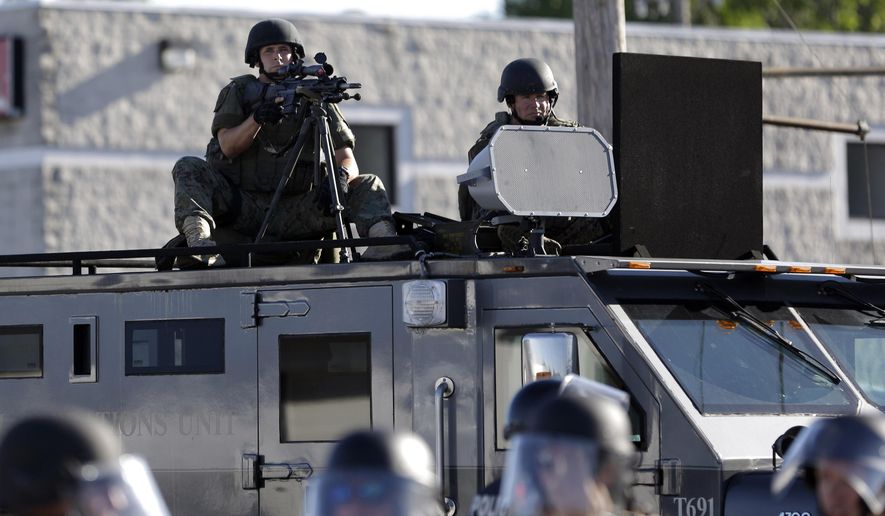President Trump reinstated a controversial program Monday to ship a wide array of surplus military equipment to local police departments, giving them access to everything from armored vehicles to grenade launchers.
The move, heralded by law enforcement groups but decried by civil rights organizations, repeals Obama-era restrictions on a Department of Defense program that sent billions of dollars of equipment to SWAT teams and public school police alike.
President Obama imposed the restrictions after a heavy-handed police response to riots in Ferguson, Missouri, in 2014, saying the federal government shouldn’t be making weapons of war available to civilian police.
Mr. Trump signed an executive order fully reinstating the Department of Defense’s 1033 program, leaving decisions about the type of military equipment appropriate to deploy on the streets largely up to local police departments. The order also deleted additional oversight and training Mr. Obama had instituted.
“Those restrictions went too far,” said Attorney General Jeff Sessions, announcing the order on Monday as he spoke at a National Fraternal Order of Police conference in Tennessee. “We will not put superficial concerns above public safety. We will do our part to get you what you need.”
Mr. Sessions said it also sends a strong message “that we will not allow criminal activity, violence and lawlessness to become a new normal.”
More than $5.4 billion in surplus military gear has been transferred to state, local and tribal law enforcement agencies under the 1033 program since 1997. Rifles, helicopters, trucks, bayonets, clothing, tools, electronics and office equipment were all available.
Mr. Obama’s policy banned transfers of items like grenade launchers, bayonets and armored, tracked vehicles. Other “controlled” equipment, like battering rams and riot helmets and shields, was still available under the program but required police departments to provide more justification in order to obtain them.
For some departments, the 1033 program had proved a hassle, with items such as armored vehicles not turning out to be as useful as local officials estimated.
But law enforcement groups by and large appreciated the federal assistance and lobbied for the program to be reinstated.
“The previous administration was more concerned about the image of law enforcement being too ‘militarized’ than they were about our safety,” said Chuck Canterbury, president of the Fraternal Order of Police.
The National Sheriffs’ Association said equipment provided to local law enforcement through the program has been used to fight terrorism and as part of local agencies’ responses during national disasters.
“The equipment sheriffs receive through this program include equipment they could not otherwise afford including additional bulletproof vests and Kevlar helmets, upgraded safety equipment, as well as larger equipment such as helicopters and robotics,” National Sheriffs’ Association President Harold Eavenson and Executive Director Jonathan Thompson said in a statement.
Officers in San Bernardino, California, used an armored vehicle during a shootout with two armed terrorists who carried out a deadly rampage at a community center. And as officers responded to a deadly mass shooting at an Orlando, Florida, nightclub, a military-style helmet saved the life of an officer struck by gunfire, officials said.
Even with the Obama-era restrictions in place, a government watchdog group said more than $203 million worth of equipment was distributed to local law enforcement through the program from Jan. 20 through June 30 this year. Over the same period last year, $130 million worth of equipment was distributed, according to the Project on Government Oversight.
Civil rights groups said reinstating the full program means militarization of police, which will lead to more strained relations with the communities they serve.
“This action puts more firepower in the hands of police departments that remain largely untrained on matters of racial bias and endangers the public,” said Janai Nelson, associate director-counsel at the Legal Defense Fund. “Inviting the use of military weaponry against our domestic population is nothing short of recasting the public as an enemy.”
Sen. Rand Paul, Kentucky Republican, said he will try to curtail the program.
“It is one thing for federal officials to work with local authorities to reduce or solve crime, but it is another for them to subsidize militarization,” Mr. Paul said. “Any order that comes today still needs to be funded, and I will bring this issue to the Senate floor.”
He said he also will reintroduce legislation to ban the transfer of items like armored vehicles and drones to police departments and to increase accountability of departments in the program.
Rep. Mark Sanford, South Carolina Republican, also expressed concern over the program, suggesting it be overhauled to require police to bid on wanted equipment. By requiring departments to pay to acquire the surplus equipment, Mr. Sanford said, departments won’t be tempted to stockpile items they don’t need.
Mr. Trump’s executive order Monday erased Obama-era guidelines and policies that required law enforcement agencies to receive instruction on how to properly use items from the program. Agencies also had to file after-action reports for any significant events in which federally provided “controlled” equipment was used.
Oversight of the program has been found to be lax in the past. The Government Accountability Office last month published results from an audit in which $1.2 million worth of surplus military equipment was shipped to investigators pretending to be a police department.
GAO auditors were able to secure more than 100 items by posing as police less than a week after submitting their requests, the report found. Using false ID and law enforcement credentials, an investigator was able to pass security checks and enter Defense Logistics Agency warehouses. Personnel at two of the three sites didn’t even bother to check for ID, according to the GAO.
• Andrea Noble can be reached at anoble@washingtontimes.com.




Please read our comment policy before commenting.